Recreate Your Favourite Locos and Aircraft
All our standard designs can be fully personalised!!
Articles, photographs or discussion related to Class 14 diesel hydraulic locos

In 1955 British Rail embarked on a huge modernisation plan that involved wholesale replacement of steam locomotives with new design diesel locomotives.
The plan saw the emergence of a wide range of locomotive types. Some types inevitably turned out to be extremely poor runners that had a very short service life plagued by very poor reliability.
Up until now, I have focussed on recreating replica loco bodyside data panel designs for the most common and popular classes.
I have now turned attention to the early pioneer classes as these are often overlooked by many rail enthusiasts despite playing a huge role in the early days of BR modernisation.
All replica loco bodyside data panel designs are created with reference to images of the original loco.
New Locomotive Classes Added –
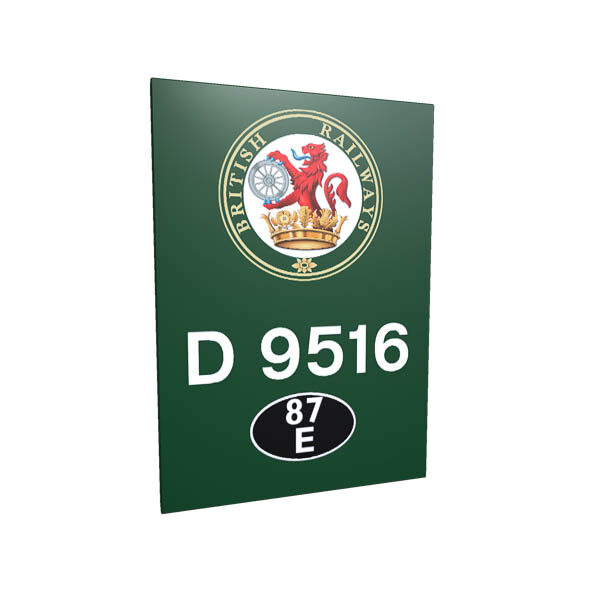
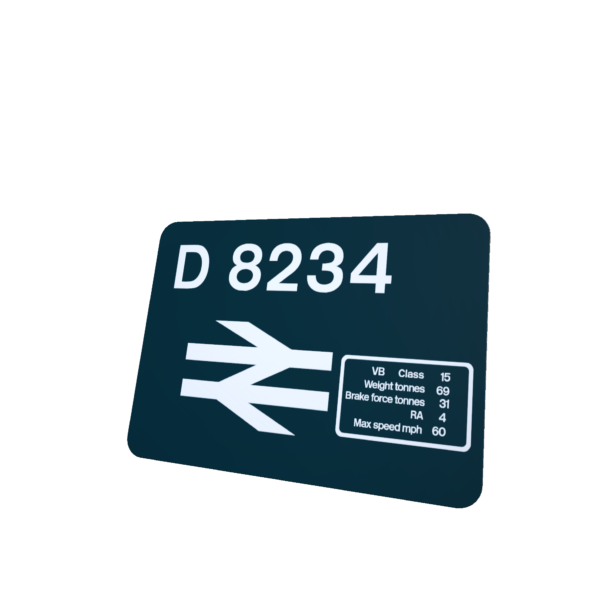
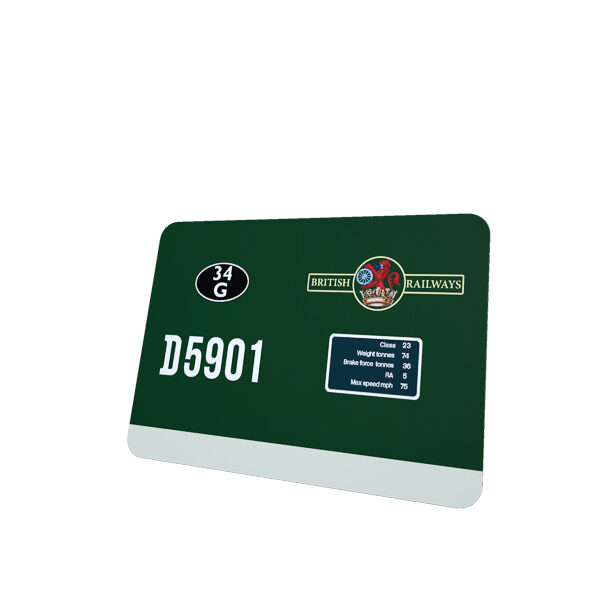
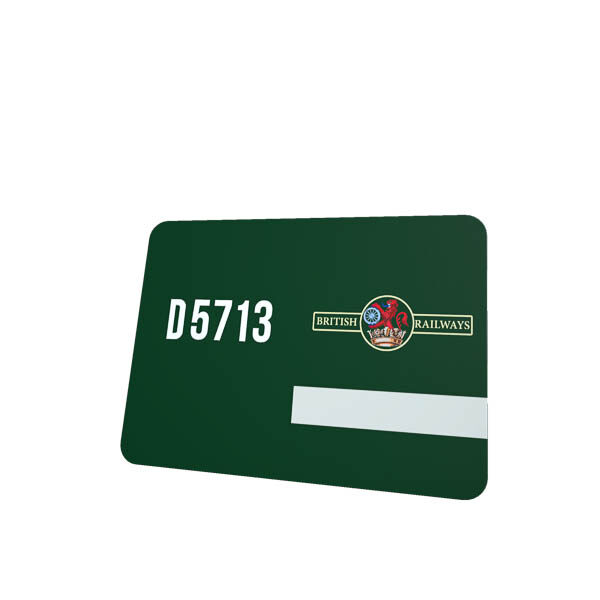
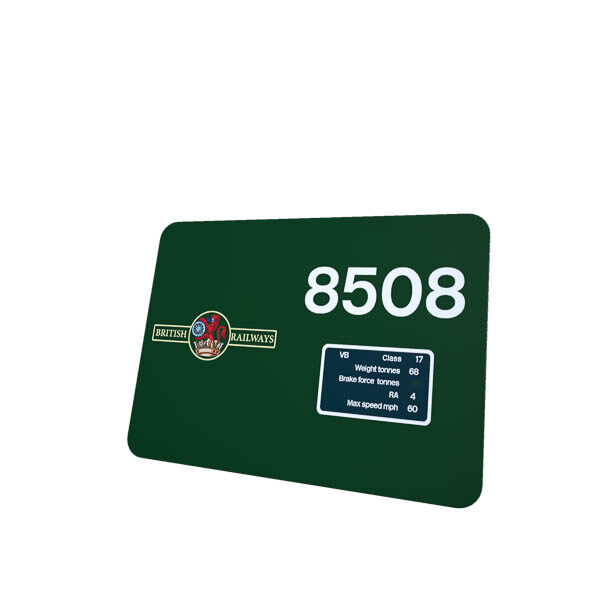
In 1965, British Rail adopted ‘Rail Blue’ as its corporate colour scheme. With this change came a new style of depot sticker and locomotive data panel.
The transition from British Rail Green to British Rail blue livery lasted through to the early 1970s and during this period, locomotives underwent a transitory phase of carrying elements of both colour schemes.
This led to a really interesting mix of looks to the locomotive fleet.
I have created a number of special edition data panels featuring these transitory looks.
Every data panel I create is taken from photographic evidence of each particular loco to ensure an accurate as possible design is created.
Whilst researching these transitory looks, I was really surprised at how fluid the application of loco numbering, logos, data panels and depot codes was.
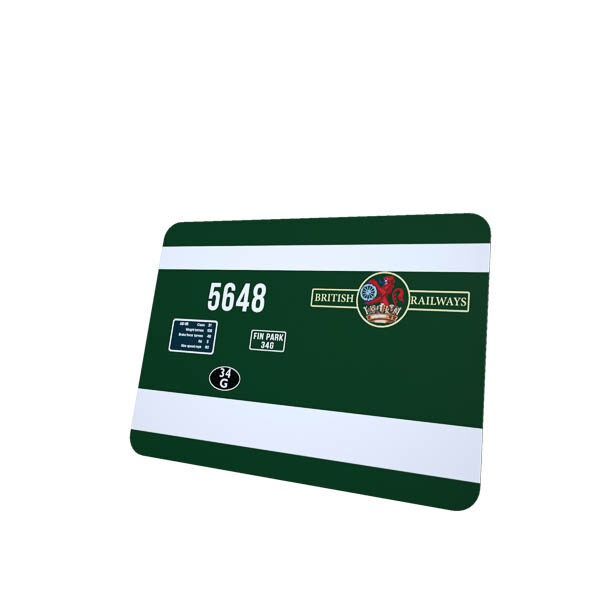

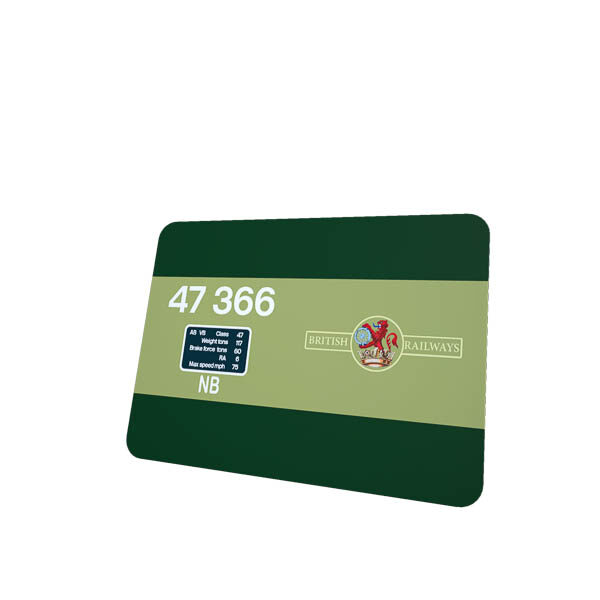
I decided a while ago to recreate some of the departmental locos and have now added the 1st two – Class 15 locos ADB 968000 and ADB 968001
I will be adding more departmental locos in the near future.
All the data panels are made up in reference to photo evidence of the particular loco when it carried the livery you choose.
To get the exact look for the period you are interested in, especially BR Green and BR Blue liveries, please specify a date in the order notes field. I will then get the data panel to look as close to the loco at that specified time.
Remember these loco data panels are available on our full range of gifts and not just metal signs!
Thanks for reading and dont hesitate to let me know your thoughts on these new loco data panels!
Stay safe
Cheers Gary
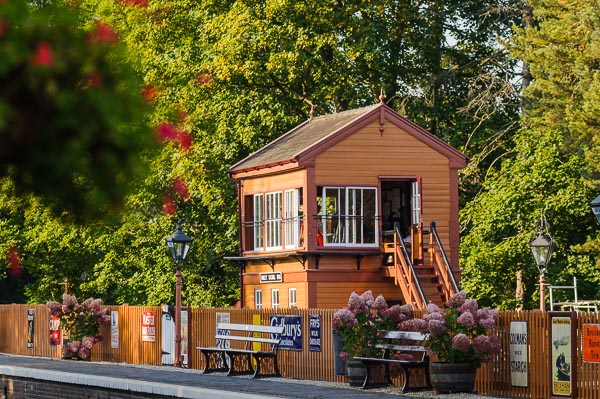
[vc_row][vc_column][vc_column_text]
The Severn Valley Railway is a preserved railway that runs 16 miles between Kidderminster and Bridgnorth. As with most of todays heritage railways, the line fell victim to the rationalisations that ravaged the railways in the 1960s. Even before the infamous Beeching Report, the Severn Valley Railway was recognised as economically unviable and identified as a candidate for closure.
The railway ran from Hartlebury through to Shrewsbury. Construction started in 1858 with final completion coming in 1862. Stations were located at Stourport-on-Severn, Bewdley, Arley, Highley, Hampton Loade, Bridgnorth, Coalport, Ironbridge, Buildwas, Cressage and Berrington.
Primary traffic for the line was coal from the collieries at Alveley and Highley. The line was never considered as financially successful.
The railway became part of the Great Western Railway in 1870.
The Great Western Railway built a link from Bewdley to Kidderminster in 1878. This connection allowed traffic access to the Black Country and West Midlands.
The line played a useful role during the Second World War as a diversion route around the Midlands.
Through passenger and freight services ended during 1963. The line was removed north of Bridgnorth soon afterwards.
Coal traffic continued from Alveley until 1969. Passenger services from Bewdley to Kidderminster and Hartlebury lasted until 1970.
In 1965 a group of local enthusiasts formed the Severn Valley Railway Society.
Their aim was to buy the section of line from Bridgnorth through to Alveley Colliery sidings near Highley.
The societies hard work was rewarded in 1970 when the first train services ran between Bridgnorth and Hampton Loade.
By 1973 sufficient funds allowed purchase of the the line from Alveley Colliery sidings, through to Highley, Arley and Bewdley as far as Foley Park, near Kidderminster.
Services started running south to Bewdley in 1974 with occasional special trains running through to Foley Park.
The railway always knew a station and connection with the national railway network at Kidderminster was vital.
British Rail traffic to the British Sugar Corporation sidings at Foley Park ceased in 1982. This presented an opportunity to buy the 1 ½ miles of railway through to Kidderminster Junction. At the same time, an agreement to lease the old Kidderminster Goods Yard from British Rail allowed the dream of a station at Kidderminster to become reality.
The new Severn Valley Railway station at Kidderminster came into use in 1984. Finally trains were able to run over the full length of the Severn Valley Railway as we know it today.[/vc_column_text][/vc_column][/vc_row][vc_row][vc_column][vc_column_text]
Today, the Severn Valley Railway is a far cry from the economically unviable railway of the early 20th Century.
The railway is predominantly operated by steam locos with a small number of services, mainly at weekends, operated by classic diesel locos. The Severn Valley Railway is the home of many types of steam and diesel locos.
Many railway preservation societies call the Severn Valley Railway their home including –
Each of these societies are focused on preserving and operating many different types of loco, coaching stock and infrastructure but each contributes to the Severn Valley Railways success. When you have read this article, please take a few minutes to read about their organisations as they deserve much support.
All stations are maintained in typical Great Western Railway styles and colours and the railway retains its authentic Great Western Railway lower quadrant signals.
Moving away from the locos, the Severn Valley Railway operates classic period rolling stock. Of particular note is the railways achievement in running full rakes of coaches from defined periods. Many railways find themselves in a position where their coaches are a mix and match of styles and eras.
The Severn Valley Railway can proudly boast its ability to run full rakes of rolling stock from the following railway companies
The LNER rake is particularly eyecatching with its varnished teak panelled exterior.
As well as running regular steam and diesel timetabled services, the Severn Valley Railway has regular theme days to attract visitors including
[/vc_column_text][/vc_column][/vc_row][vc_row][vc_column][vc_column_text]
Most visitors start their journey at Kidderminster, which is ironically the railways newest station and modelled on the original Great Western Railway station at Ross on Wye.
Kidderminster mainline station is directly adjacent to its mainline counterpart, being only a short walk across the cobbled station frontage. This provides a convenient connection for visitors using the main railway network.
At Kidderminster station you will also find the Kidderminster Railway Museum (www.krm.org.uk) and the Coalyard Miniature Railway.
[/vc_column_text][/vc_column][/vc_row][vc_row][vc_column][vc_column_text]
Bewdley has three platforms and was originally the junction station for trains to Hartlebury or Kidderminster. Adjacent to the station is a goods yard full of wagons and coaching stock.
[/vc_column_text][vc_media_grid item=”2915″ grid_id=”vc_gid:1480361748622-f00783e9-8e1d-5″ include=”26207,18126,10005,26210″][/vc_column][/vc_row][vc_row][vc_column][vc_column_text]
Trains pass here allowing you the chance to change trains.
[/vc_column_text][vc_media_grid element_width=”6″ item=”2915″ grid_id=”vc_gid:1480361748627-95173f4f-f11a-10″ include=”2889,18096″][/vc_column][/vc_row][vc_row][vc_column][vc_column_text]
Highley is a small station but also home to The Engine House. There is only one platform but several lines through the station. This a reminder of the areas important mining past and that industries reliance on the railway to get its produce to the market.
[/vc_column_text][vc_media_grid item=”2915″ grid_id=”vc_gid:1480361748631-c596e537-8cd0-2″ include=”2907,26209,10010″][/vc_column][/vc_row][vc_row][vc_column][vc_column_text]
The Engine House at Highley is an interesting visitor and education centre. On display are several steam locos for you to get up close to and get a real sense of the immense size and presence of a full-size steam loco.
Another item of interest is an original Post Office sorting vehicle. Inside you can see how mail was sorted on the go by mailmen in days gone by.
On the upper floor is an excellent cafe and viewing terrace which allows great views of passing trains.
[/vc_column_text][vc_media_grid item=”2915″ grid_id=”vc_gid:1480361748635-de2b9bec-7682-0″ include=”2908″][vc_video link=”https://youtu.be/5TV5MDwb5V8″ title=”View From The Engine House Cafe Balcony”][/vc_column][/vc_row][vc_row][vc_column][vc_column_text]
Hampton Loade is a beautiful station that seems to be in the middle of nowhere. Trains pass here allowing you the chance to change trains.
[/vc_column_text][vc_media_grid element_width=”6″ item=”2915″ grid_id=”vc_gid:1480361748637-0100d5df-49b3-6″ include=”26208,18207,14803″][/vc_column][/vc_row][vc_row][vc_column][vc_column_text]
The Severn Valley Railways northern terminus station. The buildings date back to the railways original opening in 1862, albeit with numerous changes in that time.
Bridgnorth has a locomotive works and yard. You can get an overview of the works from the platform and station overbridge but access is not allowed.
I suppose this is due to that dreaded ‘Health & Safety’ mantra that dominates the modern world – whatever happened to using common sense and taking responsibility for your own health and safety? Please, don’t get me started![/vc_column_text][/vc_column][/vc_row][vc_row][vc_column][vc_column_text]
There are many factors besides the meticulously restored stations, locomotives and coaching stock that makes the Severn Valley Railway so rich in photographic opportunities.
Each station provides fantastic opportunities for capturing or recreating period scenes. You can document the operational activities of a busy railway scene. Guards and Station Masters interact with the public, drivers attend to their locos and massive locos ooze atmosphere alongside authentic signalling equipment. There is much to inspire photographers.
The attention to detail means many period still life set pieces are everywhere including authentic signage and period baggage.
Interesting pictures can be had at the north end of Arley Station. Trains pass here and you can get some nice images of the trains passing. At the north end of the Platform is a grassy picnic area with a restricted view to the north. You can get shots of the southbound service arriving with the loco of the northbound service in the foreground. Afternoons are better due to the suns position.
At Highley, cross the bridge and walk northwards past the signalbox. Pick a point along the fence to get pictures of southbound services coming round the bend. The trains approach head on before entering the station. Telephoto lenses create a compressed field of vision for this shot. Afternoons are better when the sun has moved around.
The overbridge at Bridgnorth station provides a useful viewpoint of the yard as well as views of trains ready to depart southwards. The view southbound can be tricky with high contrast lighting being a problem most of the day.
[/vc_column_text][vc_media_grid element_width=”6″ item=”2915″ grid_id=”vc_gid:1480361748640-b9f30548-2fd1-6″ include=”5261″][/vc_column][/vc_row][vc_row][vc_column][vc_column_text]
The first location is still technically on the railway. The Engine House viewing balcony is an excellent place to relax with a cuppa and view the trains coming and going from Highley Station. I recommend this location in the afternoon as the sun will have moved around sufficiently to light your subjects.
The railway meanders, as its name suggests, through the Severn Valley and at many points is close to the Severn River. At 16 miles in length, the railway passes over several level crossings, public footpaths and bridges, all of which provide lineside photo opportunities.
The Severn Way, a long distance footpath following the River Severn, provides several vantage points for photographing the railway between Arley and Highley stations.
The most well known of these spots features the Victoria Bridge passing over the River Severn just south of Arley Station. This location is a classic photography spot on the railway and features regularly in the railway press. As with the Engine House location at Highley, lighting is more favourable in the afternoon.
You can leave the train at Arley and walk down to the river. Follow the Severn Way northwards towards Highley. Along the Severn way you will encounter several locations that set the railway in context with the surrounding countryside. This walk should be undertaken in the morning to take advantage of the morning light. In the afternoon your scene will become backlit as the sun moves around.
If you were feeling adventurous, it is possible to walk from Bewdley through to Hampton Loade. You would follow Northwood Lane until you came to the Severn Way. The route generally follows the railway and provides many different opportunities to photograph passing trains.
I must stress in the strongest terms, DO NOT TRESPASS on the railway at any time, however exceptional you think your photo could be. Trespassing is illegal. Walking around a working railway is dangerous – trains WILL kill you. Your presence is a distraction for the staff who have a job to do. Ultimately, stupid acts of trespassing usually result in unnecessary tighter controls on those of us who do respect the railway environment.[/vc_column_text][/vc_column][/vc_row][vc_row][vc_column][vc_column_text]
My lasting impression of the Severn Valley railway is overwhelmingly positive. For a start the line is a good length and trains are regularly 7 or 8 carriages long meaning the locos have to work hard in places.
Each of the stations are impeccably restored and maintained to represent a working Great Western Railway allowing yourself to be immersed in the ambience of times long since passed.
Add in the fact that the railway passes through some stunning scenery and you have a winning formula.
The railway and the hosted preservation societies provide a nice mix of large and small locos mixed in with matching rakes of coaching stock.
The railway also has regular turns for the diesel fleet which I highly commend. A lot of people think of diesels as boring, but they nevertheless played an essential role in the history of Britains railways.
Preserved railways need to remember that many people won’t remember steam trains active on the ‘real railway’. I’m in my late 40s and never saw a steam train in service. My youth is full of BR Blue diesels with compartment stock working trains to various seaside resorts.
I hope you enjoyed this overview of the Severn Valley Railway. Please take a little time to visit the groups I have linked to as restoring and running railways is an expensive, unglamorous and time consuming labour of love. The groups deserve all the support and publicity they can get.
I would love to hear your views on what I have written and am only too happy to answer any questions you might have.
All the best for now
Gary[/vc_column_text][vc_row_inner][vc_column_inner width=”1/2″][vc_column_text css=”.vc_custom_1444939361414{border-top-width: 1px !important;border-right-width: 1px !important;border-bottom-width: 1px !important;border-left-width: 1px !important;border-left-color: #0098da !important;border-left-style: solid !important;border-right-color: #0098da !important;border-right-style: solid !important;border-top-color: #0098da !important;border-top-style: solid !important;border-bottom-color: #0098da !important;border-bottom-style: solid !important;border-radius: 5px !important;}”]
Licence Railway Editorial Stock Photos
[/vc_column_text][/vc_column_inner][vc_column_inner width=”1/2″][vc_column_text css=”.vc_custom_1451259377065{border-top-width: 1px !important;border-right-width: 1px !important;border-bottom-width: 1px !important;border-left-width: 1px !important;border-left-color: #0098da !important;border-left-style: solid !important;border-right-color: #0098da !important;border-right-style: solid !important;border-top-color: #0098da !important;border-top-style: solid !important;border-bottom-color: #0098da !important;border-bottom-style: solid !important;border-radius: 5px !important;}”]
Buy Railway Wall Art Pictures and Gifts
[/vc_column_text][/vc_column_inner][/vc_row_inner][/vc_column][/vc_row][vc_row][vc_column][vc_separator color=”sky” el_width=”80″][/vc_column][/vc_row][vc_row][vc_column][vc_cta h2=”Subscribe to GDMK Images” txt_align=”center” add_button=”bottom” btn_title=”Sign me up I want to save 10% on my purchase!” btn_custom_background=”#0098da” btn_custom_text=”#fffffd” btn_link=”url:http%3A%2F%2Fstaging.gdmkimages.co.uk%2Fsubscribe-gdmk-images-newsletters%2F|title:Subscribe%20and%20save%2010%25%20off%20your%20next%20wall%20art%2C%20phone%20case%20or%20t-shirt%20purchase!|”]Subscribe and save 10% off your next wall art, phone case or t-shirt purchase![/vc_cta][/vc_column][/vc_row][vc_row][vc_column][vc_column_text]
[/vc_column_text][vc_row_inner][vc_column_inner width=”1/6″][vc_facebook type=”button_count”][/vc_column_inner][vc_column_inner width=”1/6″][vc_googleplus][/vc_column_inner][vc_column_inner width=”1/6″][/vc_column_inner][vc_column_inner width=”1/6″][/vc_column_inner][vc_column_inner width=”1/6″][/vc_column_inner][vc_column_inner width=”1/6″][/vc_column_inner][/vc_row_inner][/vc_column][/vc_row][vc_row][vc_column][vc_column_text]
[/vc_column_text][ess_grid alias=”railways”][/vc_column][/vc_row]